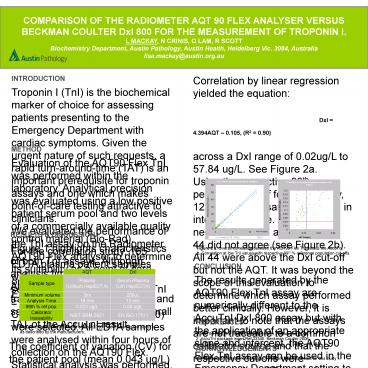VRE PowerPoint PPT Presentation
1 / 1
Title: VRE
1
COMPARISON OF THE RADIOMETER AQT 90 FLEX
ANALYSER VERSUS BECKMAN COULTER DxI 800 FOR THE
MEASUREMENT OF TROPONIN I. L MACKAY, N CRINIS, Q
LAM, R SCOTT Biochemistry Department, Austin
Pathology, Austin Health, Heidelberg Vic. 3084,
Australia lisa.mackay_at_austin.org.au
INTRODUCTION Troponin I (TnI) is the biochemical
marker of choice for assessing patients
presenting to the Emergency Department with
cardiac symptoms. Given the urgent nature of such
requests, a rapid turn-around-time (TAT) is an
important prerequisite for troponin assays and
one which makes point-of-care testing attractive
to clinicians. We evaluated the performance of
the TnI assay on the Radiometer AQT90 Flex
analyser to determine its suitability as a point
of care option for our tertiary hospital
Emergency Department.
Correlation by linear regression yielded the
equation DxI 4.394AQT 0.105, (R2
0.90) across a DxI range of 0.02ug/L to 57.84
ug/L. See Figure 2a. Using the respective 99th
percentile cut-off for each assay, 121/165 paired
samples agreed in interpretation (i.e. elevated
or negative by both assays). 44 did not agree
(see Figure 2b). All 44 were above the DxI
cut-off but not the AQT. It was beyond the scope
of this evaluation to determine which assay
performed better clinically. However, it is
important to note that the assays are not
traceable to a common calibrator source and that
the respective cut-offs were determined on
different reference populations and hence not
directly comparable. Furthermore, Beckman Coulter
has since re-formulated the AccuTnI to improve
performance at the low end.
METHOD Evaluation of the AQT90 Flex TnI was
performed within the laboratory. Analytical
precision was evaluated using a low positive
patient serum pool and two levels of a
commercially available quality control material
(Bio-Rad). For the correlation study, 165 EDTA
plasma patient samples with a corresponding
serum/lithium heparin plasma TnI 0.01 ug/L on
the Beckman Coulter AccuTnI (Unicel DxI 800) were
selected. All EDTA samples were analysed within
four hours of collection on the AQT90 Flex.
Statistical analysis was performed using a
commercial statistics program (Analyse-it,
version 2.09)
RESULTS DISCUSSION Figure 1 highlights
characteristics of both TnI assays. Although
analysis time is lower with the AccuTnI assay,
sample transportation to the laboratory and
sample preparation adds to overall TAT of the
AccuTnI result.
Figure 2 a. Overall correlation between the AQT90
Flex TnI versus the AccuTnI. b. Correlation at
low TnI values with respective 99th reference
population cut-offs.
CONCLUSION The results generated by the AQT90
Flex TnI assay are numerically different to the
AccuTnI DxI 800 assay but with the application of
an appropriate slope and intercept, the AQT90
Flex TnI assay can be used in the Emergency
Department setting to produce results comparable
to the laboratory assay. However, it is important
that clinicians are aware that the assays are
fundamentally different.
- REFERENCES
- AQT90 Flex. TnI Test Kit package Insert.
Radiometer 2008. - AccuTnI package insert Ref 33340. Beckman Coulter
2006.
Figure 1. Assay characteristics of the AQT90 Flex
TnI versus the AccuTnI as described by the
manufacturers.
The coefficient of variation (CV) for the patient
pool (mean 0.043 ug/L) was 11.2. Using QC
material, CV was 9.1 at a level of 0.42 ug/L and
11.9 at a level of 1.64 ug/L.
ACKNOWLEDGEMENTS We thank Radiometer for the
supply of reagent and instrument for this study

